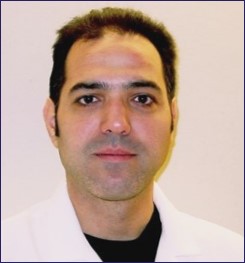2022 research grant awardees
We are excited to share with you the eight grants selected for funding in 2022 below.
The review process
The Review Committee was comprised of the PKDF Scientific Advisory Panel (SAP), additional ad hoc scientists and experts in PKD, as well as a Stakeholder Review Panel made up of PKD patients and caregivers. Each application was assigned three independent reviewers who ranked the grants based on our Guidance for Reviewers that provided separate criteria for scientists and stakeholders. Read more about our Peer Review Process here.
Rankings were based on:
- significance to PKD research
- innovation
- investigator strengths
- scientific environment
- approach.

2022 Dr. Vincent H. Gattone Research Award
Katherine Dell, M.D.
Cleveland Clinic Foundation
Project Summary
Novel MRI Fingerprinting of Congenital Hepatic Fibrosis in ARPKD Patients
Autosomal Recessive Polycystic Kidney Disease (ARPKD) affects approximately 1/20,000 children and has two main features, polycystic kidneys and the liver disease, congenital hepatic fibrosis (CHF). CHF results in progressive deleterious changes in the bile ducts of the liver and can be associated with significant, life-threatening complications, including portal hypertension (leading to severe bleeding), bile duct infection or cancer. Although kidney disease is common in many ARPKD patients early in life, CHF may not be evident until later in childhood or adulthood. As more ARPKD patients survive after kidney transplantation, significant CHF is becoming more common. Unfortunately, there are currently no disease-specific therapies and treatment is focused on addressing CHF complications. Several novel therapies have shown efficacy in animal models, but have not been studied in ARPKD patients due to the absence of safe and reliable measures of CHF progression.
Newer ultrasound (US)-based elastography methods, that measure liver stiffness (scarring) can distinguish mild vs severe CHF but may lack sensitivity to detect and measure early CHF, when therapies are most likely to be effective. Our collaborative research team (Drs. Dell & Flask) has been studying novel MRI methods to assess ARPKD kidney and liver disease progression for over a decade. In previous studies in an ARPKD animal model, we showed that T1 mapping is a sensitive measure of progressive CHF. While encouraging, one major limitation to MRI is that it usually requires long scan times and is affected by movement, which necessitates sedation/anesthesia for many children. This increases risk and would likely prevent participation of younger ARPKD children in clinical trials that use MRI.
To address this important limitation, our group has applied and optimized a novel technique, MR-Fingerprinting (MRF), to study both ARPKD kidney and liver disease. MRF allow for rapid and simultaneous acquisition of multiple imaging parameters, including T1 and T2, and is resistant to motion artifact. In a current NIH R01 longitudinal kidney imaging study, we obtained kidney MRF results in ARPKD patients with excellent repeatability and no need for intravenous contrast or sedation. With supplemental funding, we obtained initial liver MRF images, showing that mean T1 values are significantly higher in ARPKD patients with advanced CHF vs. both healthy volunteers and ARPKD patients with milder disease. The overall goal of this project is to establish liver T1-MRF as a safe, sensitive and reproducible CHF imaging biomarker that would facilitate design and implementation of future clinical trials. The Specific Aims are to evaluate T1-MRF across a spectrum of ARPKD liver disease and compare T1-MRF with US measures of liver scarring. The proposed studies would provide a key element needed to conduct clinical trials of CHF treatments and ultimately improve outcomes for ARPKD patients.
Biography

2022 Young Investigator Award
Charles DeRossi, Ph.D.
Icahn School of Medicine at Mount Sinai
Project Summary
Glycosylation as a regulator of liver disease in ARPKD
Autosomal recessive polycystic kidney disease (ARPKD) is a genetic disorder characterized by the growth of fluid-filled cysts in the kidney. The liver is also affected by the same genetic mutation in ARPKD, and as such, the majority of individuals with ARPKD will also have a liver disease called congenital hepatic fibrosis (CHF). CHF is where excessive scar tissue is deposited in the liver and can disrupt normal liver function. Currently, there are no treatments to cure the liver disease in CHF/ARPKD except for liver transplantation. Therefore, more research efforts to better understand how we can prevent or reverse liver scarring in ARPKD is essential.
This project focuses on the role of glycosylation in CHF/ARPKD. Glycosylation is the process where sugars are added to target molecules, such as proteins, to direct their function or location within or outside a cell. When glycosylation is disrupted, this can lead to a myriad of diseases, including kidney and liver diseases. Mannose is a sugar similar to glucose, and the processing of mannose is a key pathway in maintaining correct glycosylation of proteins. Our research data and clinical observations stimulated us to explore the role of glycosylation and mannose metabolism as important regulators of CHF in ARPKD. With the following aims, we will test our hypotheses that abnormal glycosylation drives liver scarring in ARPKD, and that mannose supplementation can be effective at treating ARPKD-associated liver disease.
This project is relevant to PKD as it examines an extra-renal manifestation of ARPKD from a novel viewpoint – changes in liver glycosylation associated with ARPKD and examines mannose as a potential therapy for ARPKD-associated liver disease. The Impact/Significance of this project, in addition to mannose being used therapeutically, is potentially identifying novel glycoproteins that impact severity of liver disease in ARPKD which could become therapeutic targets or diagnostic markers for severity of liver disease. This proposal provides conceptual, technical and translational innovation as it focuses on the novel idea that changes in mannose metabolism and protein glycosylation drive CHF in ARPKD patients, it uses cutting-edge glycoproteomic analyses to identify key changes in the pathobiology of CHF, and it integrates findings from divergent fields which, together, introduce the novel prospect that manipulating mannose levels in the liver can improve fibrosis in ARPKD.
Biography
Charles DeRossi, Ph.D., is an Assistant Professor in the Department of Pediatrics at the Icahn School of Medicine at Mount Sinai. He earned his Ph.D. in Biochemistry and Glycobiology from Ruprecht-Karls Universität Heidelberg in Germany, and postdoctoral training at the Icahn School of Medicine at Mount Sinai where he was awarded training grants in Investigative Gastroenterology and Transplant Immunology. Dr. DeRossi has a long history of studying how metabolic and glycosylation pathways contribute to development and disease. Most recently he has been examining the glycosylation and metabolic changes that take place during the progression of liver fibrosis and has identified the simple sugar mannose as an effective anti-fibrotic in multiple animal systems. He now aims to expand this research to study the diseased liver associated with autosomal recessive polycystic kidney disease (ARPKD), in particular identifying novel glycoproteins that play a role in driving fibrosis in the ARPKD liver, and the potential utility of mannose to lessen the progression of liver disease.

Project Summary
Effect of Whole Compared to Ultra-Processed Foods in PKD
Individuals with PKD are no different than the general population in that they are very interested in information that can help them improve their health via dietary choices. However, they are faced with a dizzying array of options of whole and processed foods and much conflicting dietary advice. The lay press is filled with dietary advice, but there are no official dietary recommendations for PKD, as indicated by the following statement on The PKD Foundation web site: “Currently no specific diet has been proven to make your polycystic kidneys better or keep them from getting worse. It is, however, ideal to eat a balanced and healthy diet to maintain optimal body conditions.” Despite recommendations by nutrition authorities to eat a balanced and healthy diet by consuming whole foods (WF), the consumption of ultra-processed foods (UPF) is still very high in human diets. These food products are highly processed, tasty, convenient, and often cheaper than buying WF. The average US diet contains 50-60% UPF. Unfortunately, these food products are generally lower in nutrients and higher in salts, sugars, fats and additives.
Evidence of the benefits of WF diets and the detrimental effects of UPF is mounting for many major chronic diseases, and recently this has been shown to be true for chronic kidney disease (CKD) as well. However, this has not been shown for PKD specifically. Therefore, the first impact of the current study is that it will address this gap in knowledge by testing the effects of well-defined WF and UPF diets on disease progression in 2 established mouse models of PKD. Animal studies allow dietary effects (and drug effects, as exemplified by Tolvaptan studies) to be tested without the confounding effects of the vast diversity in human populations, and offer a comparatively cost-efficient way to test the validity of these concepts.
The second impact of this proposal is that it will test the effects of diets based on entirely plant food sources compared to diets containing a 2/1 ratio of animal/plant protein sources, and will examine the effects of low protein compared to normal protein diets in PKD. There is interest in plant-based and lower protein diets, but the benefits of these dietary strategies remain unclear due to the often-conflicting scientific literature results. One of the sources of such inconsistencies may be due to the inclusion of UPF in studies to date, which may counteract any benefits of plant-based or protein-reduced diets. Therefore, the current study will test the effects of WF compared to UPF using diets containing animal products (e.g. common American diet) and diets composed exclusively of plant products (e.g. vegan, vegetarian diets). Further, diets will be formulated to have a low (but adequate) level of dietary protein or a normal level of protein (similar to the average American intake of protein). This will provide the first information in PKD on whether the beneficial effects of plant-based and low protein diets are influenced by food processing.
Biography
He obtained his PhD in Human Nutritional Sciences at the University of Guelph in Canada and then undertook Postdoctoral training in Human Nutrition at Texas A&M University in the USA, before coming to the University of Manitoba in 1999. His research programs are funded by the Canadian Institutes of Health Research (CIHR) and the Natural Sciences and Engineering Research Council of Canada (NSERC) and focus on the effects of nutrition in health and kidney disease and the physiologic and metabolic basis of dietary recommendations for fatty acids and proteins. Recently our laboratory has developed expertise in nutritional effects on lipid mediators called oxylipins.
Dr. Aukema has over 30 years of experience in designing and implementing dietary animal studies, most of which were in multiple models of cystic and non-cystic kidney diseases. Our laboratory group has examined effects of protein level and source, and fat level and type, in animal models of PKD. We also discovered that PKD kidneys have altered lipid mediators called oxylipins. These are bioactive lipids that are made from fatty acids and we have shown that blocking the elevated levels of oxylipins in PKD slows disease progression. Dr. Aukema has published over 125 papers, including over 30 publications and 50 presentations on our studies in animal models of PKD.

Michael Caplan, M.D., Ph.D.
Yale University
Project Summary
Can a Fragment of Polycystin-1 Unlock the Door for Gene Therapy in ADPKD?
Autosomal dominant polycystic kidney disease (ADPKD) is the most prevalent potentially lethal monogenic disorder. Approximately 78% of cases are caused by mutations in the PKD1 gene, which encodes polycystin-1 (PC1). PC1 is a large 462-kDa protein that undergoes cleavage in its N and C-terminal domains. C-terminal cleavage produces fragments that translocate to mitochondria. We have found that transgenic expression of a protein corresponding to the final 200 amino acid residues of PC1 in a Pkd1-knockout orthologous murine model of ADPKD dramatically suppresses the cystic phenotype and preserves renal function. This suppression depends upon an interaction between the C-terminal tail of PC1 and the mitochondrial enzyme Nicotinamide Nucleotide Transhydrogenase. Expression of the PC1-CTT stimulates NNT activity.
Recent data from Dr. S. Somlo’s laboratory demonstrate that re-expression of full length PC1 or PC2 can dramatically reverse advanced cystic disease attributable to inactivation of Pkd1 or Pkd2, respectively. These data suggest the intriguing possibility that development of an intervention that produces expression of functional PC proteins in the renal epithelial cells of patients could potentially not only prevent disease progression but could also diminish the severity of established cystic pathology. The development and testing of such an intervention are complicated by the fact that the cDNA encoding full length PC1 is far too large to be packaged in any currently available conventional viral gene delivery vector. Our data show that initiation of conditional PC1-CTT expression simultaneously with conditional disruption of Pkd1 substantially dampens the development of the ADPKD phenotype in a mouse model. In Aim 1 we will determine whether expression of the PC1-CTT recapitulates the capacity of the full length PC1 protein to induce the resolution of extant cysts. Were this to be the case it would constitute a strong proof of concept for the development of gene therapy strategies built around the delivery of the sequence encoding the PC1-CTT, since this sequence is only ~600 bp in length.
In Aim 2 we will take advantage of in vitro assays to define the minimal active piece of the PC1-CTT that is needed in order to mediate its effects on NNT activity and on cyst formation. The sequence that encodes the PC1-CTT and the sequence that encodes its minimal active piece will be employed in the creation of viral gene delivery vectors. We will test the capacity of these vectors to drive the expression of the encoded proteins in the epithelial cells of mouse kidneys in vivo. Will also assess whether administration of these vectors is able to slow or reverse cystic disease in orthologous mouse models of ADKPD. A demonstration that delivery of the PC1-CTT or its minimal active piece reduces ADPKD severity in vivo would provide strong support for further translational development of this approach.
Biography

Cristina Cebrian, Ph.D.
Cincinnati Children’s Hospital Medical Center
Project Summary
Unraveling the earliest cellular behaviors at the inception of ADPKD
Autosomal Dominant Polycystic Kidney Disease (ADPKD) is the most common inherited kidney disorder, and it is caused by mutations in the genes PKD1 and PKD2. ADPKD patients have one mutation in either of these genes in all their cells but, in their kidneys, some cells carry two mutations and are the ones that become cysts. There is no cure for the disease and current treatments aim at ameliorating the symptoms of cyst growth: pain, hypertension and impaired kidney function; in half of the patients, ADPKD will progress to kidney failure. In 2018, the FDA granted approval of Tolvaptan, a drug that slows down cyst growth in rapidly progressing ADPKD patients. However, not all patients are rapidly progressing, and the drug has significant liver toxicity. The disease is usually diagnosed between the ages of 30 and 50, when the increase in size of a multitude of cysts blocks the flow of blood and filtrate in nearby nephrons, therefore compromising kidney function. Despite being an “adult” disease, the mutant cells that will give rise to the cysts are believed to be already present in children.
Here we propose to study the behavior of these mutant cells at their inception, in the embryonic developing kidney, using a unique mouse model. Our rationale is that, by understanding the earliest events leading to cyst formation, we will be able to formulate better therapies addressed at the asymptomatic ADPKD pediatric population. This is a specially neglected population. Affected parents question the need to genetically or ultrasonographically identify the disease in their children given the absence of an active treatment. Their hesitance is understandable when the only possible treatments are diet and lifestyle changes that can be implemented without the label of a pre-existing condition.
Our approach relies on 1) a unique mouse model in which we can visualize with fluorescent proteins a limited number of mutant cells in the embryonic kidney, and 2) our ability to culture and image those kidneys outside of the embryo, therefore enabling us to study the earliest behaviors of the mutant cells. In our preliminary studies using this mouse model we demonstrate that a single mutant cell is responsible for the development of each cyst. In order to do so, this cell must proliferate and prevent dispersion of its daughter cells.
In this proposal we aim at answering the following questions: How is proliferation of mutant cells driven and controlled? And how do mutant cells remain together to become a cyst?
Answering these questions will allow us to identify targetable pathways to prevent cyst initiation. In contrast with current treatments that prevent cyst growth in rapidly progressing patients, by preventing cyst initiation we aim at identifying a long-lasting early therapy for children at risk for ADPKD.
Biography

Alison Kriegel, Ph.D.
The Medical University of Wisconsin
Project Summary
Targeting Tolvaptan-Resistant Mechanisms of Fibrosis in ADPKD
ADPKD is a systemic disorder in which kidneys become large due to tubular cyst expansion. This is accompanied by fibrosis (scarring) in the kidney. Tolvaptan is the only FDA-approved drug for treatment of ADPKD. It targets the V2 vasopressin receptor, causing the kidney to reabsorb less water from the urine. While tolvaptan reduces cyst size, modestly slowing the rate of declining renal function, the NIH sponsored “CRISP” study found that the decline in renal function in people with ADPKD correlated with the development of renal fibrosis, not renal size. There are no approved therapies – nor late-stage clinical candidates in development – to address fibrosis in ADPKD. PKD-associated pathology leads to alterations in blood flow and changes in the distribution of cell types within the kidney, including an invasion of inflammatory cells and proliferation of the interstitial cells. It has been proposed that rapid cyst expansion compresses blood flow, contributing to low oxygen in tissues and fibrosis. Our preliminary data our mcwPkd1(nl/nl) model of ADPKD shows that tolvaptan reduces cyst expansion, but not fibrosis. This suggests that fibrosis will be a persistent problem in people with ADPKD, even with tolvaptan treatment. Importantly, this indicates that specific therapies targeting this fibrotic mechanism, rather than cyst formation and growth alone, must be developed to affect progression of renal disease and loss of function in ADPKD. The mcwPkd1(nl/nl) provides an experimental model to dissociate and study causes of fibrosis that are independent of cyst expansion.
The “central dogma” of biology has been that that DNA is transcribed to RNA, which is translated into a functional protein. Some RNAs, called non-coding RNAs, have other functions. MicroRNAs (miRs) are very short, non-coding RNAs regulated like many protein coding genes. They are understood to bind and inhibit RNA translation. A single miR can targeting multiple RNAs causing broad regulatory effects. Our preliminary data indicate that therapeutic targeting of fibrotic signals, in addition to cyst expansion, is needed to slow progression of renal disease and loss of function in ADPKD. This proposal will focus on the role of transforming growth factor beta-1 (TGFB1) and miR-382, a miR increased in by TGFB1, on persistent fibrosis in conjunction with tolvaptan treatment in the mcwPkd1(nl/nl) model of ADPKD. Both are pro-fibrotic signaling factors, that are increased during periods of rapid fibrotic expansion in Pkd1(nl/nl) mouse models. We anticipate these studies will yield important information about the mechanisms regulating fibrosis. Further, this project has the potential to solidify the involvement of specific signaling pathways in the development of renal fibrosis. This knowledge could help develop new, focused therapeutic strategies to slow or preventing morbidity resulting from progressive fibrotic remodeling in people living with ADPKD.
Biography

Madhulika Sharma, Ph.D.
University of Kansas Medical Center
Project Summary
The role of ferritin in polycystic kidney disease
Autosomal Dominant Polycystic Kidney disease (ADPKD) is a genetic disease which is caused by mutations in PKD1, PKD2 or rarely random genes. The disease manifests with the formation of huge cysts in the kidney. Initially, the disease progresses slowly and can go unnoticed until a person is 25 to 30 years old when symptoms such as elevated blood pressure, flank pain and increase in kidney volume can be noticed. The disease progression depends on the kind of mutation, each with varying level of severity. Regardless of the mutation, there are some common molecular pathways that are affected. The discovery of these pathways is important because manipulations in these pathways may serve as a strategy to treat the disease. We have recently discovered that ferritin, a protein which maintains iron homeostasis is abnormally expressed in the collecting duct cells (CD) (kidney segment where cysts are present) and inflammatory cells (macrophages) of ADPKD kidneys. To determine the role of ferritin, we cultured cyst lining cells from ADPKD patients in a 3D collagen gel where they formed cysts. Ferritin treatment on these cysts resulted in enlargement of cysts. Cell culture studies further revealed that cyst lining cells have increased capacity for ferritin uptake which induces inflammatory pathway (NF-kappa B) activation. These results suggest that ferritin aids in cyst growth. In the first aim of this proposal, we will find if NF-kappa B activation via ferritin induces cell proliferation and inflammation. We will study the effect of ferritin treatment on disease progression in a mouse model of ADPKD. In the second aim, we will delete ferritin from the CD of ADPKD mice and determine if disease progression slows down. We will also delete ferritin from macrophages of these mice to study if these cells contribute to disease progression. If our goals are successful, the study will provide a basis for treating the disease with ferritin inhibitors.
Biography

Rudi Vennekens, Ph.D.
Flemish Institute for Biotechnology
Project Summary
Properties of sensory neurons in ADPKD, and their contribution to ADPKD related chronic pain
A very common symptom and patient reported outcome in ADPKD is acute and chronic pain. A recent study with patients and clinicians in the United States, Europe and Japan found that ADPKD-related pain was the most important outcome impacting physical functioning, with complex and distinctive presentations ranging from feeling full/discomfort to acute sharp pain. However, the source of ADPKD-related pain is poorly understood, especially for chronic pain. Therefore, pain in ADPKD patients is often under-recognized and inadequately managed. Yet, chronic, long-term pain is known to affect at least two in three ADPKD patients and is associated with reduced quality of life, often intense distress, and considerable economic and healthcare costs from emergency hospital admissions, polypharmacy (antibiotics and pain relief including morphine) and impact on work/home life.
No gold-standard modality for pain relief exists in patients with ADPKD. Indeed, the current pharmacological analgesia management in ADPKD is prescribed according to the WHO three-step analgesic ladder. However, an important caveat in this ADPKD population is the nephrotoxicity of NSAIDs and the impaired clearance of opioids, limiting their use and safety. Patients with unsatisfactorily pain relief will undergo more invasive procedures ranging from cyst aspiration, renal denervation to radical nephrectomy.
Despite the scale and burden, there has been little research into ADPKD associated pain and its treatment. Why pain occurs is inadequately understood — it is not always related to kidney size and may occur in adolescence and early stages when no other symptoms are present.
One attractive strategy is to intercept pain at the source, by targeting the sensory neurons that generate nociceptive signals. Currently, there is virtually no knowledge on the properties of sensory neurons or molecular sensory receptors in the context of ADPKD. Considering that PKD1 and PKD2 (the two predominant genes in which mutations cause ADPKD) are expressed in sensory neurons, that mutations in PKD1 and PKD2 lead to abnormalities in cellular signaling in various cell types, and that secretion of a variety of factors (such as MCP1) which influence sensory neurons is altered in ADPKD, we hypothesize that the properties of nociceptive sensory neurons are distorted in the context of ADPKD, which might contribute to the precipitation of chronic pain in ADPKD patients and could even contribute to development of the disease.
Biography
View more grant and fellowship awardees
Page last reviewed May 2023








